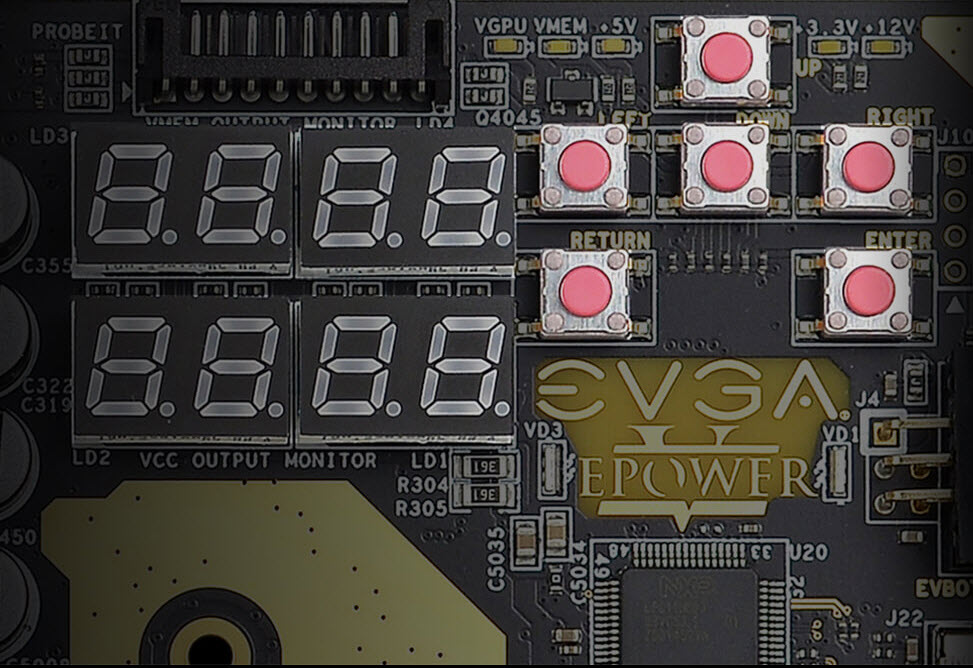EVGA Releases the EPOWER V Standalone VRM Board
EVGA for quite some time now is well known for its overclocking friendly products, from VGAs to mainboards. Besides the normal product categories though, the same company also includes in its portfolio a line of products which addresses the overclocking elite, those users who have the necessary knowledge and skill to mod super expensive VGAs and break world records by using extreme cooling solutions (LN2).
For quite some time now the company has offered special boards featuring VRMs (Voltage Regulation Modules) that can replace the ones that graphics cards and mainboards use, offering more power, rich voltage options, and increased stability under high loads. The newest addition in EVGA's VRM boards portfolio is the EPOWER V - 12+2 Phase Extreme Power VRM, which, as its model number denotes, is the fifth version of the EPOWER project.
According to EVGA, the most notable features of this product are the following:
- Onboard VCORE and VMEM LED Display - The EPOWER V features a LED Display readout to show the VCORE and VMEM in real-time.
- VMEM - Voltage adjustment range from 600mV to 2300mV. Rated capacity is 80A. Maximum peak capacity - 90A at 1.9V output voltage.
- VCORE - Voltage adjustment range is 600mV to 2000mV. Rated capacity is 600A. Maximum peak capacity - 620A at 1.85V output voltage.
- Onboard VCORE and VMEM LED Display - The EPOWER V features a LED Display readout to show the VCORE and VMEM in real-time.
- Control the EPOWER V remotely using the integrated EVBot MKII - Use the built-in EVBOT MKII buttons to adjust the voltages on the fly, or upgrade the board's firmware and connect the EVBot to control the graphics card remotely.
- USB 3.1 Type-C and Software Controls - The EPOWER V provides the ability to control the output voltages. You can use the USB 3.1 Type-C port to connect to a PC and use software to control the EPOWER V board.
- Droop, Force, and Offset Voltage Switches - To further customize the EPOWER V, use the available DIP switches to use remote sense to control for VDROOP. You are able to force your overclock voltages, and/or Offset your voltages for increased stability.
- ProbeIT - ProbeIT connectors allow the easily hook up a device to a multimeter in order to accurately read voltages on-demand.
- Fan Headers - The EPOWER V board needs cooling and thankfully it is already equipped with fan connectors. You can use one or two 12v fans to keep its temperatures under control.
For those who still don't know what the EPOWER V actually does, it is simple. It can replace the VRMs, which are in essence a circuit that takes a voltage (in this case 12V DC) and converts it to another voltage (in this case from 0.6V to 2.3V for VMEM and 0.6V to 2.0V for VCORE), of your graphics card. Both VGAs and mainboards have VRMs (also known as DC-DC converters) which allow them to convert the voltages that a PSU provides.
So you can think of the VRM as a mini-PSU, with the only difference being that it takes as an input DC voltage instead of AC. The EPOWER V can be considered as a top dog PSU (actually DC-DC buck converter since it lowers the input DC voltage) which replaces the one used by your graphics card or mainboard, however its installation isn't so straightforward but needs skills and electronics knowledge, since you will have to isolate the existing VRM(s) and connect (actually solder) the EPOWER V.
The EPOWER V board is powered by three 6-pin PCI-E power connectors and it has a 12 phase main output (0.6 - 2.0V, 600A) for VCORE and a 2 phase secondary output (0.6 - 2.3V, 80A) for VMEM. Besides increased power and stability it gives you the ability to easily adjust the VCORE and VMEM voltages on the fly, something highly useful of course to any overclocker. Like every good DC-DC converter the EPOWER V is also protected by all necessary protection features including some warning features: OVP, UVP, OC Warn, OCP, OT Warn, OTP. The cherry on top is that you can adjust the triggering points of some protections.
The regulation circuit is digital and the controller, IR3595A, is provided by International Rectifier. This is a highly interesting controller which, besides providing real time monitoring through an I2C bus, also offers programmable Constant Current Protection. The same controller utilizes an Adaptive Transient Algorithm (ATA) that allows for smaller output (also called bulk) capacitors and improves on the same time transient response, which is what matters the most, because huge transient loads are routine when power-hungry GPUs and CPUs are used for benching.
Get Tom's Hardware's best news and in-depth reviews, straight to your inbox.
You will find more information on this toy and a guide on how to install it on an EVGA GeForce GTX 1080 Ti reference graphics card in this forum thread.
The EPOWER V is already available at a price of $250 and, according to EVGA, is only covered by a special DOA-type warranty due to complexity of use. This means that every single EPOWER is tested before shipment and can be replaced only if it’s not working out of the box, with an ATX PSU attached to it. If you modified your VGA or soldered EPOWER down, there will be no replacements, so be sure to check the EPOWER's correct output prior to connecting it with a graphics card.

Aris Mpitziopoulos is a contributing editor at Tom's Hardware, covering PSUs.
-
blackwolfecreativeconcepts $250 is a pretty hefty price to pay. But I wonder if something like this would benefit the current line up of AMD AM4 ITX boards which all suffer from vel problems. A bit pricey for a fix...Reply


